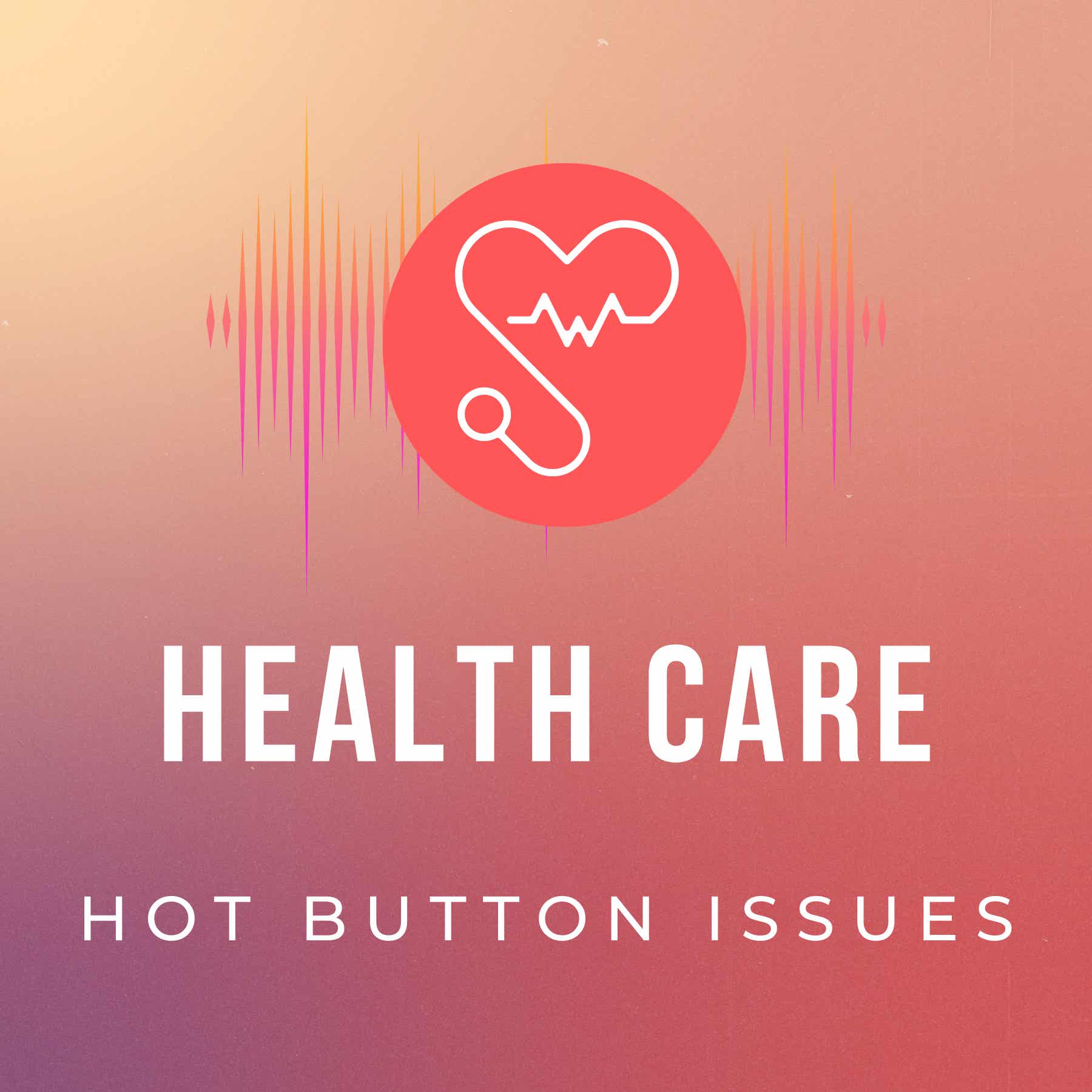 |
Healthcare Hot Button IssuesTranslating scientific findings into plain language to answer challenging healthcare questions of our time. Perspectives and insights you won't be able to find in other venues. Let us know your topics of interest! Thanks for joining. Author: Translating Scientific Findings for the Public
We strive to translate scientific findings to answer your burning questions about healthcare in plain language. Let us know the topics of your interest. We would love to cover them! Please leave comments or email us: Support@AnalyticaNow.net. We explain health care issues based on scientific evidence and include topics such as medical conditions, health economics, cost, physician, clinic & hospital payment, prescription drugs, and nursing & long-term care. You can follow us on Facebook: https://www.facebook.com/HotButtonIssues and Twitter: https://twitter.com/buttonissues The podcast is provided by Analytica Now, a company specializing in health analytics, economics, and policy. The views expressed are the author's and not those of Analytica Now. hotbutton.substack.com Language: en Genres: Health & Fitness, Medicine, Science, Social Sciences Contact email: Get it Feed URL: Get it iTunes ID: Get it |
Listen Now...
Amazon Care vs. One Medical: a Tale of Two Primary Care Innovation Models
Sunday, 25 September, 2022
On July 21, 2022, Amazon announced its $3.9 billion bid for One Medical, a primary care innovator. Some industry observers consider this a smart move by Amazon, while others think this might be another failed attempt. The deal is currently under regulatory review by the Federal Trade Commission.Just several weeks later, Amazon decided to terminate Amazon Care, its telehealth operation, by the end of 2022. In an email to employees, Neil Lindsay, the senior vice president of Amazon Health Services, said:“Although our enrolled members have loved many aspects of Amazon Care, it is not a complete enough offering for the large enterprise customers we have been targeting and wasn’t going to work long-term.”Why did Amazon decide to discontinue Amazon Care and acquire One Medical in the meantime? How are these two models different? How can One Medical generate savings and become sustainable in the long term? Below is our analysis to shed some light on these questions.Amazon Care is essentially a telehealth provider and uses a fee-for-service payment model.Amazon Care was launched in 2019 to serve its own employees and their family members located in the State of Washington. In June 2021, Amazon Care expanded its virtual care to all 50 states. It provides a virtual care platform; clinical services are contracted out to Care Medical, a third-party medical group. Surprisingly, it does not have a mission statement on its website.Amazon Care is essentially a telehealth provider, supplemented by home-based services from nurses. It offers 24/7 virtual care, including video care or care chat. It is fast: customers are promised to be connected to a clinician within 60 seconds.When recommended by a video care clinician and approved by the customer, a nurse will visit the customer’s home or workplace to perform physical examinations, conduct testing, administer vaccines, or collect lab samples. Its home-based services are only available in select locations and do not involve diagnosis or treatment.Amazon Care is paid on a fee-for-service basis. Eligible employees use their insurance sponsored by their employers and are responsible for co-pay, co-insurance, and deductibles.Amazon Care is not much different from traditional telehealth providers, and it is thus nearly 20 years late to the employer market and has failed to gain traction.Compared to existing telehealth providers such as Teladoc Health, Amazon Care does not differentiate itself much. It provides home-based services, but only nurses visit customers’ homes, and they provide only ancillary services rather than medical care that involves diagnosis and treatment. In other words, it does not offer meaningful in-person care that would differentiate itself from competing telehealth providers. In-person care is critical to managing chronic medical conditions and building trust between clinicians and customers.Unlike Teladoc Health, Amazon Care does not offer chronic condition management and monitoring services. According to the Centers for Disease Control and Prevention, individuals with chronic medical conditions account for 90% of the total healthcare spending. In comparison, after acquiring Livongo in 2020, Teladoc Health gained capabilities of chronic condition management and monitoring via connected devices.Given a lack of meaningful differentiation in telehealth offerings, Amazon Care is just another telehealth provider. But considering Teladoc was launched in 2002, Amazon Care is nearly 20 years late to the employer market. This is one of the reasons that it has not gained much traction. As of 2022, less than 10 major employers use Amazon Care, including Whole Foods, one of Amazon’s subsidiaries.By the way, this is not the first time Amazon has failed in healthcare due to a lack of differentiation. You can read our analysis on why Haven Healthcare - its joint venture with JP Morgan and Berkshire Hathaway - did not fly.Amazon Care is supplemental to the existing healthcare system and unlikely to generate sustainable savings.In the absence of in-person care offerings, a telehealth provider like Amazon Care is only supplemental to the existing inefficient system used by employers, who have to pay additional fees for telehealth services. In Amazon’s own words,“…the company's program is supplemental and additional to coverage already offered – not a substitute for health insurance already offered to its employees. In fact, only workers already participating in company-offered healthcare insurance can participate in Amazon Care.”Being a supplement to the existing healthcare system creates additional fragmentation in care delivery that tends to lead to waste and inefficiency.Without the capabilities of managing chronic conditions, building long-term trusting relationships with customers, and changing the existing healthcare delivery approach meaningfully, it is very unlikely that Amazon Care will generate savings and become a long-term solution for employers.In contrast, One Medical has a hybrid model - both virtual and in-person care - with significant differentiation from traditional primary care and has achieved high customer satisfaction.Founded in San Francisco, CA in 2007, One Medical uses a “human-centered, technology-powered model” to transform primary care to achieve three aims: better care, better health, and lower cost. Last year, it spent $2.1 billion to acquire Iora Health, a primary care innovator serving the Medicare Advantage market.The company is growing fast. In the last six months, it added 62,000 members, equivalent to an annual growth rate of 17%. Currently, One Medical has 204 physical offices in 25 markets, serving 8,500 employers, 750,000 employees and their family members, and 40,000 Medicare or Medicaid beneficiaries.One Medical offers convenient and quality care. It provides 24/7 on-demand virtual care available within minutes, same-day or next-day appointments for in-person care, and an inviting physical office environment at convenient locations. Its brick-and-mortar offices and in-person care allow One Medical to build long-term relationships with customers, manage chronic medical conditions and high-need patients, and offer a wide range of wellness programs.The core differentiator is its “team-based and salaried provider model.” Clinicians are not subject to perversive incentives under a fee-for-service system. Clinicians see “35% fewer patients than average,” and its technology platform allows them to spend less time on documenting and more time with customers.So far, One Medical has generated high customer satisfaction, with a net promoter score of 90 in 2021, which is calculated as the difference between the percentage of customers who recommend the services and that among those who do not.In the first half of 2022, One Medical has nearly quadrupled its capitation-based revenue and thus down-weighted the importance of its fee-for-service revenue.One Medical has four major sources of revenue: membership fees, health partnership fees, fee-for-service revenue, and Medicare capitation revenue. The company charges an annual fee of $199 per member, with a total of $86 million in 2021 (14% of the total revenue). One Medical provides primary care services to enterprise customers covered by health partners and receives per-employee fixed fees ($224 million in 2021, 36%). The company also receives payments for clinical services on a fee-for-service basis and care management services from certain payers ($182 million in 2021, 29%). Capitation revenue from Medicare amounted to $127 million in 2021, 20% of the total revenue.During the first six months of 2022, capitation revenue from Medicare increased at an annual rate of 400% to $253 million. As a result, capitation revenue accounts for 50% of the total revenue. This also leads to a decrease in the weight of the fee-for-service revenue from 29% to 15%.However, One Medical has been losing money, and it might be fighting an uphill battle to become profitable.In 2020 and 2021, the company lost $90 million and $256 million, respectively. In the first six months of 2022, it had a loss of $185 million or $370 million on an annual basis.There are several possible explanations. First, One Medical is investing about 18% of its revenue in the technology platform, new physical offices, and other infrastructure for future expansion. In addition, it spends about 10% of its revenue on marketing and sales.Second, its general and administrative expenses are very high, accounting for 52% of the total revenue in 2021, which was partially due to the acquisition of Iora Health. But it decreased considerably in the first six months of 2022 to 37% of the revenue. It is likely that the company has not reached the economics of scale beyond which point, the average administrative expense per member will come down dramatically.Lastly but importantly, it is generally considered challenging to generate savings from primary care innovation. Primary care spending accounts for 5 to 8% of the total healthcare spending in the U.S., but prime care clinicians do not control the rest of 92 to 95% of spending on specialty and hospital care unless they act as a gatekeeper, which is not common.Also, academic research does not lend us much confidence either. Existing studies on primary care innovations have shown inconsistent findings: some demonstrate savings while others do not. In particular, the 4-year Comprehensive Primary Care Initiative (CPC) and the first two years of its successor - CPC Plus - reduced the growth rate of hospital admissions and emergency department visits but failed to achieve a statistically significant decline in the total cost of care.Fortunately, there might be a way out, and it seems One Medical is heading in the right direction.A promising approach is to take risks and manage the health of a population. This is because Primary care innovation can only sustain in a payment environment where two-thirds or more expenses are reimbursed on a capitation basis. The fall of Turntable Health is a case in point.Using the above approach, the savings generated by primary care innovation through reductions in unnecessary care, urgent or emergent care, and hospitalizations could be used to improve primary and preventive care. A portion of savings would become part of the company’s bottom line.It seems the company is heading in the right direction as its capitation-based revenue from Medicare has quadrupled during the first half of 2022. One Medical can also leverage its existing network of specialty and hospital providers to offer quality and efficient care. In addition, as membership grows, the company will be able to reap the benefits of economies of scale and result in lower administrative expenses per member.Further, high member retention rates are critical to One Medical’s long-term profitability. This is largely due to the fact that potential savings increases as a member’s tenure increases. Given high customer satisfaction, its member retention rate should be high.One Medical’s at-risk arrangement with Medicare has the right target population. It takes time, years or even decades, to materialize the economic benefits of wellness and prevention in a relatively healthy population. Managing the Medicare population increases the chance of generating short- and medium-term savings because the Medicare population incurs higher spending than the working population.SummaryAiming to innovate primary and urgent care, Amazon Care, in its current form, does not differentiate itself sufficiently from traditional virtual care providers and has not been able to gain traction in the employer market.In stark contrast, One Medical has a number of differentiators from traditional primary care providers. Although facing challenges in generating sustainable savings, its at-risk arrangements with Medicare holds promise and has been growing very fast.Based on what we observed, it is therefore not surprising that Amazon decided to shut down Amazon Care and acquire One Medical.—Let us know the topics of your interest (support@AnalyticaNow.net). We would love to cover them. The article is provided by Analytica Now, a company specializing in health analytics, economics, and policy. Thank you for being part of our community! 🎉 This is a public episode. If you would like to discuss this with other subscribers or get access to bonus episodes, visit hotbutton.substack.com











